#june henry nation
Explore tagged Tumblr posts
Text









Sweet Time by June Henry
x x x / x x x / x x x
#june henry#june henry nation#stimboard#GO STREAM INFINITE MONEY GLITCH NOW#i dont even do stimboards usually
35 notes
·
View notes
Text
JUNE HENRY FANS IM CALLING YOU TO ATTENTION!!!!
i have made a june henry discord server for anyone to join. it’s very like. randomly put together. but hey it exists! feel free to join
2 notes
·
View notes
Text
HEY YOU FUCKERZ I MADE A JUNE HENRY COMMUNITY DM ME IF YOU WANNA JOIN <333
3 notes
·
View notes
Text
BONKERS!
4 notes
·
View notes
Text
alex being like “i need to kidnap the prince of wales” and june and nora being like “wtf why” and alex realizes he doesn’t know why. he just needs to. he stumbles out some excuse. he will later realize this was so important bcuz he’s in love with the prince of wales and just needed to be with him.
#idk this is vaguely national treasure 2 inspired#au concept#rwrb#rwrb book#red white and royal blue book#red white and royal blue#alex claremont diaz#june claremont diaz#nora holleran#henry fox mountchristen windsor#prince henry rwrb#prince henry of wales#firstprince#alternative universe#alternate universe
42 notes
·
View notes
Text
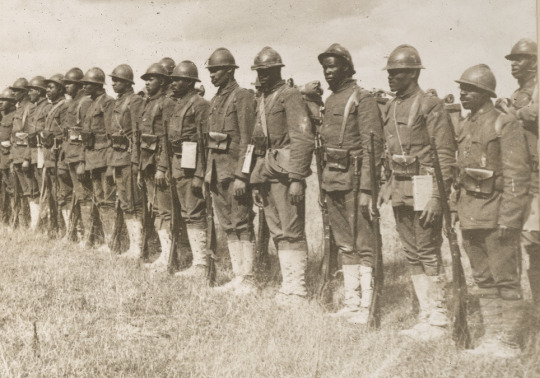

Men of the Harlem Hellfighters (369th Infantry), some of whom had been awarded the Croix de Guerre by France for their courage under fire, on June 11, 1918.
Record Group 165: Records of the War Department General and Special Staffs
Series: American Unofficial Collection of World War I Photographs
File Unit: Colored Troops
Image description: A line of Black soldiers standing shoulder to shoulder in a grassy field. They are wearing World War I U.S. Army uniforms and narrow metal helmets.
Transcription:
SUBJECT: 165-WW-127-4 NUMBER EU
165 WW-127 4
Inter. Film Ser. Photographer
Rec'd June 11, 1916 Taken
DESCRIPTION:
NEGRO TROOPS IN FRANCE.
Picture shows a part of the 15th Regt. Inf. N.Y.N.G organized by Col. Haywood, which has been under fire. Two of the men Privates Johnson and Roberts, displayed exceptional courage while under fire and routed a German Raiding party for which the negroes were decorated with the French Croix de Guerre. it will be noticed that the men have taken to the French trench helmet instead of the flatter and broader British style.
#archivesgov#June 11#1918#1910s#World War I#WWI#military#U.S. Army#Black history#African American history#Harlem Hellfighters#369th Infantry#15th New York National Guard#Henry Johnson#Henry “Black Death” Johnson#Needham Roberts#who lied about his age to enlist and was seventeen at this time
157 notes
·
View notes
Text
tag drop
#;;you can read all about it ( memes )#;;it's time to turn it up game on ( queue )#;;you've got the words to change a nation ( ooc )#;;now it's just me myself and i ( lockwood )#;;don't rain on my parade ( rachel )#;;i don't have any reasons i've left them all behind ( marley )#;;here comes the sun ( dani )#;;when the bones are good the rest don't matter ( buck )#;;she's the king of new york ( katherine )#;;there's just no telling how far i'll go ( sarah )#;;everyone thinks that i have it all ( morgana )#;;i truly believe i am quite capable of something more ( eloise )#;;restless hearts sleep alone tonight ( brimsley )#;;sometimes you just jump and hope it's not a cliff ( henry )#;;i was born to run i don't belong to anyone ( june )#;;everybody stares as she goes by 'cause they can see the flame that's in her eyes ( nora )#;;it's so empty living behind these castle walls ( martha )#;;you can just...feel ( nick )#;;and sings a solitary song that whistles in the wind ( lucy )#;;and bring on all the pretenders i'm not afraid ( james )#;;not gone just lost ( nate )#;;au contraire mon frère ( mae )#;;and i'll be holding all the fines ( JJ )#;;second star to the right and then straight ahead 'til morning light ( wendy )#;;no one decides my fate but me ( belle )#;;someday maybe all my dreams will be repaid ( ryan )#;;i wanna listen to my own heart talking ( troy )#;;that's how superheroes learn to fly ( winn )#;;my shower head is very impressed with me ( ricky )#;;i haven't heard anyone try that since the noughties ( roxy )
1 note
·
View note
Text

I feel that one of the most overlooked aspects of studying the French Revolution is that, in 18th-century France, most people did not speak French. Yes, you read that correctly.
On 26 Prairial, Year II (14 June 1794), Abbé Henri Grégoire (1) stood before the Convention and delivered a report called The Report on the Necessity and Means of Annihilating Dialects and Universalising the Use of the French Language(2). This report, the culmination of a survey initiated four years earlier, sought to assess the state of languages in France. In 1790, Grégoire sent a 43-question survey to 49 informants across the departments, asking questions like: "Is the use of the French language universal in your area?" "Are one or more dialects spoken here?" and "What would be the religious and political impact of completely eradicating this dialect?"
The results were staggering. According to Grégoire's report:
“One can state without exaggeration that at least six million French people, especially in rural areas, do not know the national language; an equal number are more or less incapable of holding a sustained conversation; and, in the final analysis, those who speak it purely do not exceed three million; likely, even fewer write it correctly.” (3)
Considering that France’s population at the time was around 27 million, Grégoire’s assertion that 12 million people could barely hold a conversation in French is astonishing. This effectively meant that about 40% of the population couldn't communicate with the remaining 60%.
Now, it’s worth noting that Grégoire’s survey was heavily biased. His 49 informants (4) were educated men—clergy, lawyers, and doctors—likely sympathetic to his political views. Plus, the survey barely covered regions where dialects were close to standard French (the langue d’oïl areas) and focused heavily on the south and peripheral areas like Brittany, Flanders, and Alsace, where linguistic diversity was high.
Still, even if the numbers were inflated, the takeaway stands: a massive portion of France did not speak Standard French. “But surely,” you might ask, “they could understand each other somewhat, right? How different could those dialects really be?” Well, let’s put it this way: if Barère and Robespierre went to lunch and spoke in their regional dialects—Gascon and Picard, respectively—it wouldn’t be much of a conversation.
The linguistic make-up of France in 1790
The notion that barely anyone spoke French wasn’t new in the 1790s. The Ancien Régime had wrestled with it for centuries. The Ordinance of Villers-Cotterêts, issued in 1539, mandated the use of French in legal proceedings, banning Latin and various dialects. In the 17th and 18th centuries, numerous royal edicts enforced French in newly conquered provinces. The founding of the Académie Française in 1634 furthered this control, as the Académie aimed to standardise French, cementing its status as the kingdom's official language.
Despite these efforts, Grégoire tells us that 40% of the population could barely speak a word of French. So, if they didn’t speak French, what did they speak? Let’s take a look.
In 1790, the old provinces of the Ancien Régime were disbanded, and 83 departments named after mountains and rivers took their place. These 83 departments provide a good illustration of the incredibly diverse linguistic make-up of France.


Langue d’oïl dialects dominated the north and centre, spoken in 44 out of the 83 departments (53%). These included Picard, Norman, Champenois, Burgundian, and others—dialects sharing roots in Old French. In the south, however, the Occitan language group took over, with dialects like Languedocien, Provençal, Gascon, Limousin, and Auvergnat, making up 28 departments (34%).
Beyond these main groups, three departments in Brittany spoke Breton, a Celtic language (4%), while Alsatian and German dialects were prevalent along the eastern border (another 4%). Basque was spoken in Basses-Pyrénées, Catalan in Pyrénées-Orientales, and Corsican in the Corse department.
From a government’s perspective, this was a bit of a nightmare.
Why is linguistic diversity a governmental nightmare?
In one word: communication—or the lack of it. Try running a country when half of it doesn’t know what you’re saying.
Now, in more academic terms...
Standardising a language usually serves two main purposes: functional efficiency and national identity. Functional efficiency is self-evident. Just as with the adoption of the metric system, suppressing linguistic variation was supposed to make communication easier, reducing costly misunderstandings.
That being said, the Revolution, at first, tried to embrace linguistic diversity. After all, Standard French was, frankly, “the King’s French” and thus intrinsically elitist—available only to those who had the money to learn it. In January 1790, the deputy François-Joseph Bouchette proposed that the National Assembly publish decrees in every language spoken across France. His reasoning? “Thus, everyone will be free to read and write in the language they prefer.”
A lovely idea, but it didn’t last long. While they made some headway in translating important decrees, they soon realised that translating everything into every dialect was expensive. On top of that, finding translators for obscure dialects was its own nightmare. And so, the Republic’s brief flirtation with multilingualism was shut down rather unceremoniously.
Now, on to the more fascinating reason for linguistic standardisation: national identity.
Language and Nation
One of the major shifts during the French Revolution was in the concept of nationhood. Today, there are many ideas about what a nation is (personally, I lean towards Benedict Anderson’s definition of a nation as an “imagined community”), but definitions aside, what’s clear is that the Revolution brought a seismic change in the notion of French identity. Under the Ancien Régime, the French nation was defined as a collective that owed allegiance to the king: “One faith, one law, one king.” But after 1789, a nation became something you were meant to want to belong to. That was problematic.
Now, imagine being a peasant in the newly-created department of Vendée. (Hello, Jacques!) Between tending crops and trying to avoid trouble, Jacques hasn’t spent much time pondering his national identity. Vendéen? Well, that’s just a random name some guy in Paris gave his region. French? Unlikely—he has as much in common with Gascons as he does with the English. A subject of the King? He probably couldn’t name which king.
So, what’s left? Jacques is probably thinking about what is around him: family ties and language. It's no coincidence that the ‘brigands’ in the Vendée organised around their parishes— that’s where their identity lay.
The Revolutionary Government knew this. The monarchy had understood it too and managed to use Catholicism to legitimise their rule. The Republic didn't have such a luxury. As such, the revolutionary government found itself with the impossible task of convincing Jacques he was, in fact, French.
How to do that? Step one: ensure Jacques can actually understand them. How to accomplish that? Naturally, by teaching him.
Language Education during the Revolution
Under the Ancien Régime, education varied wildly by class, and literacy rates were abysmal. Most commoners received basic literacy from parish and Jesuit schools, while the wealthy enjoyed private tutors. In 1791, Charles-Maurice de Talleyrand (5) presented a report on education to the Constituent Assembly (6), remarking:
“A striking peculiarity of the state from which we have freed ourselves is undoubtedly that the national language, which daily extends its conquests beyond France’s borders, remains inaccessible to so many of its inhabitants." (7)
He then proposed a solution:
“Primary schools will end this inequality: the language of the Constitution and laws will be taught to all; this multitude of corrupt dialects, the last vestige of feudalism, will be compelled to disappear: circumstances demand it." (8)
A sensible plan in theory, and it garnered support from various Assembly members, Condorcet chief among them (which is always a good sign).
But, France went to war with most of Europe in 1792, making linguistic diversity both inconvenient and dangerous. Paranoia grew daily, and ensuring the government’s communications were understood by every citizen became essential. The reverse, ensuring they could understand every citizen, was equally pressing. Since education required time and money—two things the First Republic didn’t have—repression quickly became Plan B.
The War on Patois
This repression of regional languages was driven by more than abstract notions of nation-building; it was a matter of survival. After all, if Jacques the peasant didn’t see himself as French and wasn’t loyal to those shadowy figures in Paris, who would he turn to? The local lord, who spoke his dialect and whose land his family had worked for generations.
Faced with internal and external threats, the revolutionary government viewed linguistic unity as essential to the Republic’s survival. From 1793 onwards, language policy became increasingly repressive, targeting regional dialects as symbols of counter-revolution and federalist resistance. Bertrand Barère spearheaded this campaign, famously saying:
“Federalism and superstition speak Breton; emigration and hatred of the Republic speak German; counter-revolution speaks Italian, and fanaticism speaks Basque. Let us break these instruments of harm and error... Among a free people, the language must be one and the same for all.”
This, combined with Grégoire’s report, led to the Décret du 8 Pluviôse 1794, which mandated French-speaking teachers in every rural commune of departments where Breton, Italian, Basque, and German were the main languages.
Did it work? Hardly. The idea of linguistic standardisation through education was sound in principle, but France was broke, and schools cost money. Spoiler alert: France wouldn’t have a free, secular, and compulsory education system until the 1880s.
What it did accomplish, however, was two centuries of stigmatising patois and their speakers...
Notes
(1) Abbe Henri Grégoire was a French Catholic priest, revolutionary, and politician who championed linguistic and social reforms, notably advocating for the eradication of regional dialects to establish French as the national language during the French Revolution.
(2) "Sur la nécessité et les moyens d’anéantir les patois et d’universaliser l’usage de la langue francaise”
(3)On peut assurer sans exagération qu’au moins six millions de Français, sur-tout dans les campagnes, ignorent la langue nationale ; qu’un nombre égal est à-peu-près incapable de soutenir une conversation suivie ; qu’en dernier résultat, le nombre de ceux qui la parlent purement n’excède pas trois millions ; & probablement le nombre de ceux qui l’écrivent correctement est encore moindre.
(4) And, as someone who has done A LOT of statistics in my lifetime, 49 is not an appropriate sample size for a population of 27 million. At a confidence level of 95% and with a margin of error of 5%, he would need a sample size of 384 people. If he wanted to lower the margin of error at 3%, he would need 1,067. In this case, his margin of error is 14%.
That being said, this is a moot point anyway because the sampled population was not reflective of France, so the confidence level of the sample is much lower than 95%, which means the margin of error is much lower because we implicitly accept that his sample does not reflect the actual population.
(5) Yes. That Charles-Maurice de Talleyrand. It’s always him. He’s everywhere. If he hadn’t died in 1838, he’d probably still be part of Macron’s cabinet. Honestly, he’s probably haunting the Élysée as we speak — clearly the man cannot stay away from politics.
(6) For those new to the French Revolution and the First Republic, we usually refer to two legislative bodies, each with unique roles. The National Assembly (1789): formed by the Third Estate to tackle immediate social and economic issues. It later became the Constituent Assembly, drafting the 1791 Constitution and establishing a constitutional monarchy.
(7) Une singularité frappante de l'état dont nous sommes affranchis est sans doute que la langue nationale, qui chaque jour étendait ses conquêtes au-delà des limites de la France, soit restée au milieu de nous inaccessible à un si grand nombre de ses habitants.
(8) Les écoles primaires mettront fin à cette étrange inégalité : la langue de la Constitution et des lois y sera enseignée à tous ; et cette foule de dialectes corrompus, dernier reste de la féodalité, sera contraint de disparaître : la force des choses le commande
(9) Le fédéralisme et la superstition parlent bas-breton; l’émigration et la haine de la République parlent allemand; la contre révolution parle italien et le fanatisme parle basque. Brisons ces instruments de dommage et d’erreur. .. . La monarchie avait des raisons de ressembler a la tour de Babel; dans la démocratie, laisser les citoyens ignorants de la langue nationale, incapables de contréler le pouvoir, cest trahir la patrie, c'est méconnaitre les bienfaits de l'imprimerie, chaque imprimeur étant un instituteur de langue et de législation. . . . Chez un peuple libre la langue doit étre une et la méme pour tous.
(10) Patois means regional dialect in French.
#frev#french revolution#cps#mapping the cps#robespierre#bertrand barere#language diversity#amateurvoltaire's essay ramblings
780 notes
·
View notes
Text
Measuring purely by confirmed kills, the worst mass murderer ever executed by the United States was the white supremacist terrorist Timothy McVeigh. On April 19, 1995, McVeigh detonated a massive bomb at the Murrah federal building in Oklahoma City, killing 168 people, including 19 children. The government killed McVeigh by lethal injection in June 2001. Whatever hesitation a state execution provokes, even over a man such as McVeigh — necessary questions about the legitimacy of killing even an unrepentant soldier of white supremacy — his death provided a measure of closure to the mother of one of his victims. “It’s a period at the end of a sentence,” said Kathleen Treanor, whose 4-year old McVeigh killed.
McVeigh, who in his own psychotic way thought he was saving America, never remotely killed on the scale of Kissinger, the most revered American grand strategist of the second half of the 20th century.
The Yale University historian Greg Grandin, author of the biography Kissinger’s Shadow, estimates that Kissinger’s actions from 1969 through 1976, a period of eight brief years when Kissinger made Richard Nixon’s and then Gerald Ford’s foreign policy as national security adviser and secretary of state, meant the end of between three and four million people. That includes “crimes of commission,” he explained, as in Cambodia and Chile, and omission, like greenlighting Indonesia’s bloodshed in East Timor; Pakistan’s bloodshed in Bangladesh; and the inauguration of an American tradition of using and then abandoning the Kurds.
No infamy will find Kissinger on a day like today. Instead, in a demonstration of why he was able to kill so many people and get away with it, the day of his passage will be a solemn one in Congress and — shamefully, since Kissinger had reporters like CBS’ Marvin Kalb and The New York Times’ Hendrick Smith wiretapped — newsrooms. Kissinger, a refugee from the Nazis who became a pedigreed member of the “Eastern Establishment” Nixon hated, was a practitioner of American greatness, and so the press lionized him as the cold-blooded genius who restored America’s prestige from the agony of Vietnam.
Not once in the half-century that followed Kissinger’s departure from power did the millions the United States killed matter for his reputation, except to confirm a ruthlessness that pundits occasionally find thrilling. America, like every empire, champions its state murderers. The only time I was ever in the same room as Henry Kissinger was at a 2015 national-security conference at West Point. He was surrounded by fawning Army officers and ex-officials basking in the presence of a statesman.
2K notes
·
View notes
Photo


Happy heavenly birthday to Robert Henry Lawrence Jr., the United States’ first Black astronaut! 🚀👨🏾🚀
Lawrence was a highly skilled pilot who, at age 31, was assigned to the @usairforce and National Reconnaissance Office’s’ Manned Orbiting Laboratory after graduating from the former’s Test Pilot School in June 1967.
Just six months after his assignment, Lawrence was killed in a jet crash while training — and he never had the opportunity to launch into space.
Today we honor Lawrence’s accomplishments and the strides that he made for future generations of Black Americans. 🕊️
#robert henry lawrence jr.#astronaut#us air force#air force#national reconnaissance office#space#outer space#black history
177 notes
·
View notes
Text
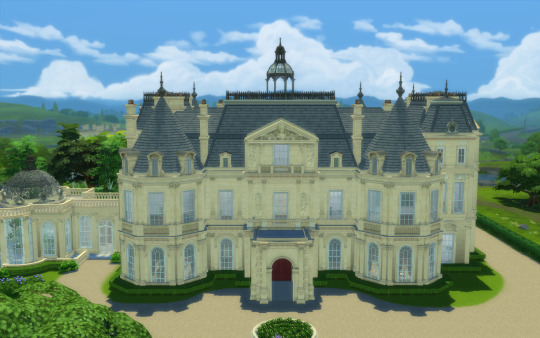
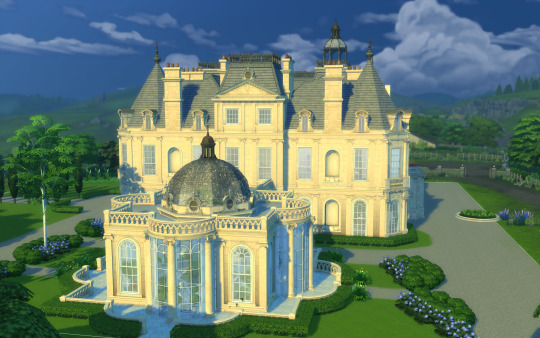


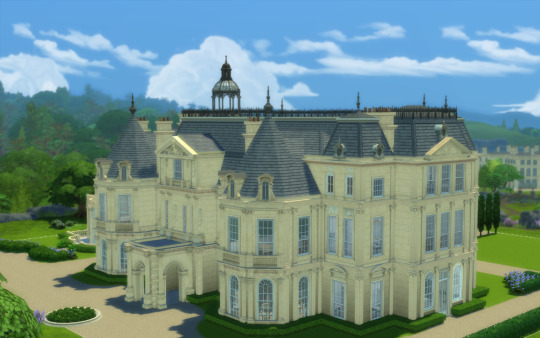

Halton House
Hace un instante
Hi guys!!
I'm sharing Halton House. This is the 15th building for my English Collection and the second Rothchild house I recreated.
I decorated some interiors for reference, but I could not find the real distribution of the house, so I just worked with pictures I found.
You might be familiar to the central hall and stairs, as they are the ones used for Bridgerton House in the series.
I chose to build the version with the conservatory, as I think this was a glory lost to time.







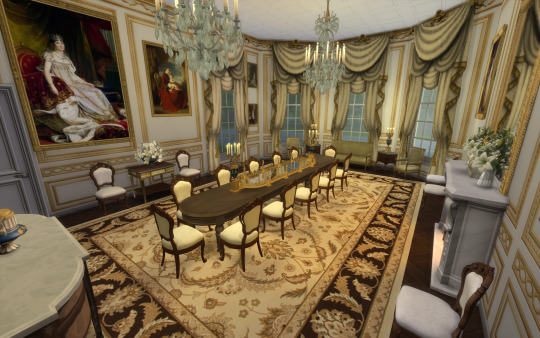
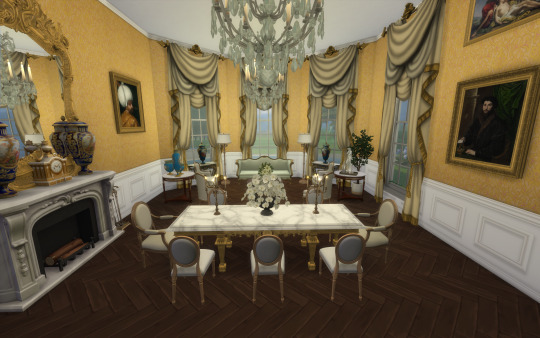




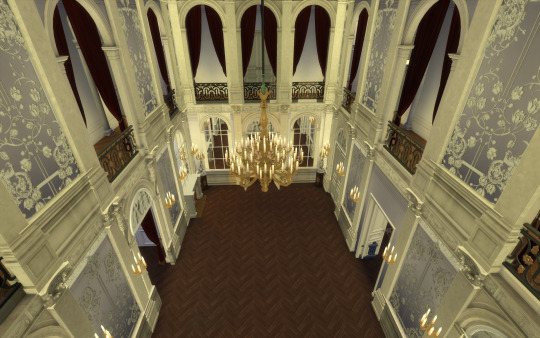


History of the house: Halton House is a country house in the Chiltern Hills above the village of Halton in Buckinghamshire, England. It was built for Alfred Freiherr de Rothschild between 1880 and 1883. It is used as the main officers' mess for RAF Halton and is listed Grade II* on the National Heritage List for England.
There has been a manor house at Halton since the Norman Conquest, when it belonged to the Archbishop of Canterbury. Thomas Cranmer sold the manor to Henry Bradshaw, Solicitor-General in the mid-16th century. After remaining in the Bradshaw family for some considerable time, it was sold to Sir Francis Dashwood in 1720 and was then held in the Dashwood family for almost 150 years.
The site of the old Halton House, or Manor, was west of the church in Halton village. It had a large park, which was later bisected by the Grand Union Canal. In June 1849 Sir George Dashwood auctioned the contents and, in 1853, the estate was sold to Lionel Freiherr de Rothschild.
Lionel then left the estate to his son Alfred Freiherr de Rothschild in 1879. At this time the estate covered an approximately 1,500-acre (610-hectare) triangle between Wendover, Aston Clinton, and Weston Turville.
It is thought the architect was William R. Rodriguez (also known as Rogers), who worked in the design team of William Cubitt and Company, the firm commissioned to build and oversee the project in 1880. Just three years later the house was finished.
The house was widely criticised by members of the establishment. The architect Eustace Balfour, a nephew of the Marquess of Salisbury, described it as a "combination of French Chateau and gambling house", and one of Gladstone's private secretaries called it an "exaggerated nightmare".
At Halton all were entertained by Alfred Freiherr de Rothschild. However, Halton's glittering life lasted less than thirty years, with the last party being in 1914 at the outbreak of World War I. Devastated by the carnage of the war, Freiherr de Rothschild's health began to fail and he died in 1918. Alfred had no legitimate children, so the house was bequeathed to his nephew Lionel Nathan de Rothschild. He detested the place and sold the contents at auction in 1918. The house and by now diminished estate were purchased for the Royal Air Force by the Air Ministry for what was even then a low price of £115,000 (equivalent to £7.08 million in 2023 pounds).
Architecture
For the style of the house Alfred was probably influenced by that of plans for the nearly completed Waddesdon Manor, the home of Baron Ferdinand de Rothschild, his brother-in law. While not so large there is a resemblance, but other continental influences appear to have crept in: classical pediments jut from mansard roofs, spires and gables jostle for attention, and the whole is surmounted by a cupola. The front of the house features a porte-cochère. A Rothschild cousin described it as: "looking like a giant wedding cake".
If the outside was extravagant, the interior was no anti-climax. The central hall (not unlike the galleried two-storey hall at Mentmore Towers) was furnished as the "grand salon". Two further drawing rooms (the east and west) continued the luxurious theme. The dining and billiards rooms too were furnished with 18th-century panelling and boiseries. The theme continued up the grand, plaster panelled staircase to the bedrooms. The whole was furnished in what became known as "Le Style Rothschild", that is, 18th-century French furniture, boulle, ebony, and ormolu, complemented by Old Masters and fine porcelain.
A huge domed conservatory known as the winter garden was attached to the house.
For more info: https://en.wikipedia.org/wiki/Halton_House
------------------------------------------------------------------------------



This house fits a 64x64 lot (You can fit the main building to the 50x50 or 50x40 lot if you lose the garden and conservatory)
I furnished just the principal rooms, so you get an idea. The rest is unfurnished so you create the interiors to your taste!
Hope you like it.
You will need the usual CC I use:
all Felixandre cc
all The Jim
SYB
Anachrosims
Regal Sims
King Falcon railing
The Golden Sanctuary
Cliffou
Dndr recolors
Harrie cc
Tuds
Lili's palace cc
Please enjoy, comment if you like it and share pictures with me if you use my creations!
Early access: 08/18/2024
DOWNLOAD: https://www.patreon.com/user?u=75230453
#sims 4 architecture#sims 4 build#sims4#sims 4 screenshots#sims4building#sims4play#sims 4 historical#sims4palace#sims 4 royalty#ts4#sims4life#sims 4 cc#sims 4#sims 4 legacy#sims 4 gameplay#thesims4#the sims 4#ts4cc#ts4 download#ts4 simblr#ts4 gameplay#my sims#sims community#simblr#ts4 screenshots#ts4 legacy
135 notes
·
View notes
Photo
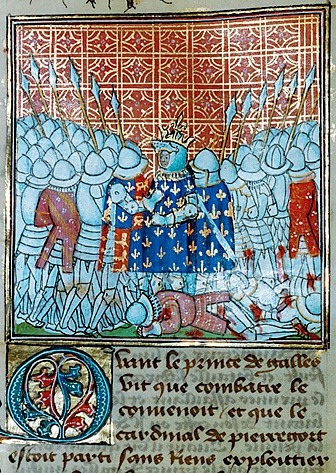
Battle of Poitiers, 1356 CE
The Battle of Poitiers on 19 September 1356 CE was the second great battle of the Hundred Years' War (1337-1453 CE) after Crécy (1346 CE) and, once again, it was the English who won. Edward the Black Prince (1330-1376 CE), son of Edward III of England (r. 1327-1377 CE), masterminded victory largely thanks to the continued domination of the powerful longbow weapon, Edward's excellent defensive positioning, and the outdated reliance of heavy cavalry by the French leadership. The French king, John the Good, aka John II of France (r. 1350-1364 CE), was captured along with many other knights and their ransoms provided the English treasury with a massive boost. A major consequence of the battle was that it allowed Edward III to keep 25% of France under the 1360 CE Treaty of Brétigny. The battle also cemented the reputation of the Black Prince as one of the greatest of all medieval knights.
Aftermath
After Poitiers, France, without its leaders, descended into the abyss of chaos. Most immediately, the disbanded French mercenaries who had fought so poorly caused havoc as they raided the surrounding area. Then King Edward pressed his advantage by marching on Rheims in 1359 CE, fully intending to have himself made king of the French where their monarchs were traditionally crowned. Rheims proved impregnable, though, and a harsh winter so reduced Edward's army he was obliged to start peace talks. In May 1360 CE a treaty was signed between England and France. Under the Treaty of Brétigny, Edward's claim to 25% of France (mostly in the north and south-west) was recognised and, in return, he gave up any ambition for the French crown itself.
The Hundred Years' War carried on as Charles V of France, aka Charles the Wise (r. 1364-1380 CE) proved much more capable than his predecessors and began to claw back the English territorial gains. Edward III was now too old to campaign and was showing signs of senility. The Black Prince died, probably of dysentery, in June 1376 CE and so England's martial prowess suffered a serious setback. Now, the only lands left in France belonging to the English Crown were Calais and a thin slice of Gascony. During the reign of Richard II of England (r. 1377-1399 CE) there was largely peace between the two nations but under Henry V of England (r. 1413-1422 CE), the wars flared up again and witnessed the great English victory at the Battle of Agincourt in October 1415 CE. Henry was so successful that he was even nominated as the heir to the French king Charles VI of France (r. 1380-1422 CE). Henry V died before he could take up that position, and the arrival of Joan of Arc (1412-1431 CE) in 1429 CE saw the beginning of a dramatic rise in French fortunes as King Charles VII of France (r. 1422-1461 CE) took the initiative. The weak rule of Henry VI of England (r. 1422-61 & 1470-71 CE) saw a final English defeat as they lost all French territories except Calais at the wars' end in 1453 CE.
Continue reading...
33 notes
·
View notes
Text
To understand the full context of the American-led ‘53 coup against Mosaddegh in Iran it is imo critical to recognize anti-communism as a proximate cause. Write-up below:
It is commonly understood that the early decades of the 20th century in Iran are characterized by British colonial extortion of material resources (mostly oil) within the boundaries of “Persia” (pre-1935) / “Iran” (post). The penultimate monarchical dynasty, the Qajars, were ousted in 1925—but the exile of the last Qajar Ahmad Shah was the direct result of the 1921 military coup led by then-Reza Khan (later the first “Pahlavi”, Reza Shah) which was directed by Britain. And at this time, British anxieties heavily featured concerns about Bolshevik encroachment from the Caucuses (not just through the newly-formed Azerbaijan SSR, but also through domestic sympathizers that fueled such projects as large as the transient Persian SSR, put down by Reza Khan after Soviet withdrawal).
This is stage-setting. Of course, by the 50s, in tandem with Cold War thread-pulling, the Anglo-Iranian Oil Company constituted a thirsty tentacle of British imperialism sucking Abadan dry and contributing pittances to the local economy. It was in the midst of decades of growing resentment against this presence that Mosaddegh became Prime Minister in 1951 as the leader of the broad National Front coalition, and we are familiar with how intensely he campaigned for nationalizing the country’s oil and how pissy this made the British (here’s one and another post on the subject if not).
Here’s the detour: you may know that it was the CIA, an American institution, that orchestrated the ‘53 coup to oust Mosaddegh. But we were just now discussing threats against British colonial power in Iran. How did things get from B to A, as it were? We can’t take this for granted.
The British in fact spent the intervening two years trying to get Mosaddegh out by mobilizing the Shah and various right-wing (often clerical and mercantile) interests in Iran (this point, and much of what follows, draws from bits of Darioush Bayandor’s Iran and the CIA and Mostafa Elm’s Oil, Power, and Principle). They spent the same two years desperately trying to get the Americans on board with their efforts. But—here it is—the Truman regime and American foreign policy was in general intensely hostile to this strain of British interventionism in Iran, going so far as to issue warnings against it.
Why? Well, as you would expect, the Americans were concerned about Soviet influence in the region. Then-U.S ambassador in Tehran Henry Grady claimed that “Mosaddegh’s National Front party is the closest thing to a moderate and stable element in the national parliament” (Wall Street Journal, June 9 1951). This summarizes the American position at the time: Mosaddegh’s nationalist movement constituted the bastion against communism, and the US was very interested in the survival of this bastion lest Iran align with the USSR.
What happened between 1951 and 1953 is that British pressure, operating through the Shah and more conservative elements of the Iranian government, jeopardized moderate support for Mosaddegh. With the right and center-right against him an entire wing of National Front coalition was falling off, and Mosaddegh found himself leaning more and more on the strengthening Tudeh Party, which had grown in numbers to militaristic significance during Mosaddegh’s tenure (including a network of at least 600 officers in the state military). Tudeh, of course, was the pro-Soviet communist party in Iran. And now the threads come together.
It was in this context of Mosaddegh, backed into a corner with almost only the communists behind him, that the CIA released a memo on November 20th, 1952 singing a very different tune:
It is of critical importance to the United States that Iran remain an independent and sovereign nation, not dominated by the USSR...
Present trends in Iran are unfavorable to the maintenance of control by a non-communist regime for an extended period of time. In wresting the political initiative from the Shah, the landlords, and other traditional holders of power, the National Front politicians now in power have at least temporarily eliminated every alternative to their own rule except the Communist Tudeh Party...
It is clear that the United Kingdom no longer possesses the capability unilaterally to assure stability in the area. If present trends continue unchecked, Iran could be effectively lost to the free world in advance of an actual Communist takeover of the Iranian Government. Failure to arrest present trends in Iran involves a serious risk to the national security of the United States.
And (!!!)
In light of the present situation the United States should adopt and pursue the following policies:...
Be prepared to take the necessary measures to help Iran to start up her oil industry and to secure markets for her oil so that Iran may benefit from substantial oil reserves...
Recognize the strength of Iranian nationalist feeling; try to direct it into constructive channels and be ready to exploit any opportunity to do so
It took two tries for the CIA to bring about a coup that removed Mosaddegh from power, but the objective of this coup was not the preservation of British control over Iranian resources; it was the maintenance of the Western sphere of influence against communist revolution (this was further prioritized by the arrival of the Eisenhower administration). In fact, after the coup the Anglo-Iranian Oil Company (now renamed British Petroleum) had to make room for six other companies from the US, France, and the Netherlands as part of a consortium, and this consortium would split profits with Iran 50/50. This is, to be clear, still colonialist extraction! But it constitutes a huge blow to British economic interests, because they were never the CIA’s goal. This is part of why the post-coup government is characterized far more as a US puppet than a British one.
It does remain that this was a sequence of events very much set in motion because of actions taken by the British government; by the time they managed to get shit to hit the fan, though, it was very much no longer in their control where the shit was flying.
614 notes
·
View notes
Text
THIS DAY IN GAY HISTOR
based on: The White Crane Institute's 'Gay Wisdom', Gay Birthdays, Gay For Today, Famous GLBT, glbt-Gay Encylopedia, Today in Gay History, Wikipedia, and more … January 6




1367 – Richard II of England (d.1400), born Prince Richard of Bordeaux was the second, but only surviving child, of Edward, Prince of Wales (also known as the Black Prince and the eldest son and heir of King Edward III) and his wife, in Bordeaux, Gascony, where the Black Prince was serving at the time. At the age of four, Richard became second in line to the throne upon the death of his elder brother, Edward of Angouleme, and heir apparent when his father, the Black Prince, died five years later (1376). Richard was dubbed a Knight of the Garter by his grandfather only months before the old king died on June 21, 1377. With the death of Edward III, Richard ascended the throne as King Richard II at the young age of ten.
Richard was deemed fit to govern and a series of councils were set up to conduct business in the king's name for the next three years. When the first of these councils met, not only was John of Gaunt, Richard's powreful uncle left out, but also the king's other remaining uncles, Edmund of Langley and Thomas of Woodstock, the Earls of Cambridge and Buckingham respectively. But although John of Gaunt had no official title in Richard's government, he was to remain a leading and influential political figure for nearly the entire reign, though he and the king would not be without their differences.
The young Richard managed to weather a number of crises, including the Peasant's Revolt at the ripe old age of 14. During the following years, the king gradually came of age and moved closer to reaching his majority reign. It was also during this period that he began to come under the influence of a small group of courtiers that were to greedily consume all of his attentions. This group consisted of three primary figures: Sir Simon Burley, the king's tutor since he was a young child; Michael de la Pole, the king's chancellor and Earl of Suffolk after 1385; and Robert de Vere, Earl of Oxford, whom Richard would ultimately upgrade to Marquis and, soon after, Duke of Ireland.
Richard's close friendship to DeVere was disagreeable to the political establishment. This displeasure was exacerbated by the earl's elevation to the new title of Duke of Ireland in 1386. The chronicler Thomas Walsingham suggested the relationship between the king and DeVere was of a homosexual nature, possibly due to a resentment Walsingham had toward the king.
On top of this, it was also wondered whether Richard was a homosexual since he never bore any children. When thinking of the reign of Richard II, it is difficult not to compare it with that of his great-grandfather, Edward II (another supposed homosexual). Like Edward, Richard had difficulty making decisions for himself and came to be dependent on a small group of favorites for advice, usually bad advice, to run the realm.
This reliance on favorites turned the nobility against him, and he was eventually deposed by Henry IV, and died in captivity in 1400.


1412 – Joan Of Arc, Roman Catholic Saint and national heroine of France (this is a legendary date) (d.1431); Joan wore men's clothing between her departure from Vaucouleurs and her abjuration at Rouen. This raised theological questions in her own era and raised other questions in the twentieth century. The technical reason for her execution was a biblical clothing law. The nullification trial reversed the conviction in part because the condemnation proceeding had failed to consider the doctrinal exceptions to that stricture.
Doctrinally speaking, she was safe to disguise herself as a page during a journey through enemy territory and she was safe to wear armor during battle. The Chronique de la Pucelle states that it deterred molestation while she was camped in the field. Clergy who testified at her rehabilitation trial affirmed that she continued to wear male clothing in prison to deter molestation and rape. Preservation of chastity was another justifiable reason for cross-dressing: her apparel would have slowed an assailant, and men would be less likely to think of her as a sex object in any case.
She referred the court to the Poitiers inquiry when questioned on the matter during her condemnation trial. The Poitiers record no longer survives but circumstances indicate the Poitiers clerics approved her practice. In other words, she had a mission to do a man's work so it was fitting that she dress the part. She also kept her hair cut short through her military campaigns and while in prison. Her supporters, such as the theologian Jean Gerson, defended her hairstyle, as did Inquisitor Brehal during the Rehabilitation trial.
Because Joan wore men's clothes and armor, scholars have speculated about her gender identity and sexuality. Did Joan wear male apparel because she was transgendered? Or did she do so in order to be taken seriously by the men whose support she needed to carry out the orders given by her visions? Was Joan a lesbian or bisexual, if those English terms may be applicable to a French woman living almost six hundred years ago? What relationship did her gender expression have with her sexuality? What about Joan's emphasis throughout her life on her virginity?
It is difficult adequately to address these personal issues based on the historical evidence that we now possess. It is clear, however, that Joan's cross-dressing was a significant part of her life, and that as a cross-dressed warrior and military leader she was venerated by French royalty, soldiery, and peasantry alike.


1854 – English fictional detective, born; What!? Sherlock Holmes? Why include the famous, hawk-nosed detective, a figment of Sir Arthur Conan Doyle's fertile imagination? Why? Because almost no one realizes that Sherlock Holmes, whom his creator almost named "Sherinford," was Gay.
He was, of course, the first consulting detective, a vocation he followed for 23 years. In January 1881, he was looking for someone to share his new digs at 221B Baker Street, and there being no personal ads in the Village Voice or The Advocate (remember those?) in those days, a friend introduced him to Dr. John H. Watson.
Before agreeing to share the flat, the two men, immediately attracted to one another, listed their respective character deficiencies. Holmes admitted to smoking a smelly pipe, although he didn't mention that he was a frequent user of cocaine. Watson owned up to a peculiar habit of leaving his bed at odd hours of the night.
"I have another set of vices," he admitted, but, then, so did Sherlock. The two became friends and roommates for the rest of their lives. For the sordid details of the famous marriage of true minds that followed, read Rex Stout's astonishing "Watson Was Woman," in which the famous creator of Nero Wolfe (himself hardly a paragon of butch studliness) reveals that Watson and Holmes were the most extraordinary Gay team in sleuthing history.
In 1971, The Traveller's Companion, Inc., an affiliate of Olympia Press, published a book based on the assumption that Holmes and Watson were lovers: The Sexual Adventures of Sherlock Holmes. Claiming to be from a newly-discovered secret cache of John Watson's papers, the book retells, very erotically, some of the original stories. It is hard-core gay porn at its best!


1961 – Bill Hayes is an American non-fiction writer and photographer. He has written four books – Sleep Demons, Five Quarts, The Anatomist, and Insomniac City – and has produced one book of photography, How New York Breaks Your Heart. His freelance writing has appeared in a number of periodicals, most notably The New York Times.
Hayes was born in Minneapolis, Minnesota, the fifth of six children, five of them girls. He remains close with his sisters. His mother Jean was an artist; his father John a military man who had lost an eye as a paratrooper in the Korean War. When Bill was three, the family moved to Spokane, Washington, where his father bought a Coca-Cola bottling plant. His mother opened an art school, where Hayes learned to develop and print film. Hayes was close with his maternal grandmother, Helen, from the age of eleven until he left home for college. In high school, Hayes was drawn to the writing of Joan Didion. Hayes attended Santa Clara University in California.
Hayes knew he was gay at a young age, though he had relationships with women in high school and college. He came out at age 24, and considers his orientation to be a core part of his identity.
Hayes' father never accepted him as a gay man and did not maintain a relationship with him, but when John Hayes developed dementia, he came to believe Bill was an old Army friend, and spoke with him warmly. Bill's mother also suffered with dementia until her death in 2011.
Hayes lived in San Francisco for many years, where he worked at the San Francisco AIDS Foundation. His partner of sixteen years was HIV-positive. In 2009, Hayes moved to New York City, where he had a relationship with neurologist and writer Oliver Sacks, until the latter's death in 2015. Hayes' experiences in New York and his six-year relationship with Sacks are the subject of his book Insomniac City.
Hayes has described his adult life as "colored by death" – the deaths he dealt with in his AIDS Foundation work, the sudden death of his longtime partner in San Francisco, and later the death of his partner Oliver Sacks.


1965 – Bjørn Lomborg is a Danish author and adjunct professor at the Copenhagen Business School as well as President of the Copenhagen Consensus Center. He is former director of the Danish government's Environmental Assessment Institute (EAI) in Copenhagen. He became internationally known for his best-selling and controversial book, The Skeptical Environmentalist (2001), in which he argues that many of the costly measures and actions adopted by scientists and policy makers to meet the challenges of global warming will ultimately have minimal impact on the world’s rising temperature.
Lomborg spent a year as an undergraduate at the University of Georgia, earned an M.A. degree in political science at the University of Aarhus in 1991, and a Ph.D. degree in political science at the University of Copenhagen in 1994.
Lomborg is gay and a vegetarian. As a public figure he has been a participant in information campaigns in Denmark about homosexuality, and states that "Being a public gay is to my view a civic responsibility. It's important to show that the width of the gay world cannot be described by a tired stereotype, but goes from leather gays on parade-wagons to suit-and-tie yuppies on the direction floor, as well as everything in between".


1968 – Today is the birthday of the Hungarian politician Gábor Szetey. Szetey is the former Secretary of State for Human Resources, a role he held since July 2006. He is a member of the Hungarian Socialist Party.
Szetey publicly declared that he was gay at the opening night of Budapest's Gay and Lesbian Film Festival, on July 6, 2007. He is the first LGBT member of government in Hungary, and the second politician to come out, after Klára Ungár. Szetey's coming out came at the end of a speech on equality and tolerance:
"When we can be proud of being Hungarian, Romanian, Jewish, Catholic, Gay or Straight... If we can be proud of our differences, we will be proud of our similarities. I believe in God. And I believe that all men and women have the right to love and be loved. Everywhere. Love has no party preference. Neither does happiness or choosing a partner. So: I am Szetey Gábor . I am European, and Hungarian. I believe in God, love, freedom, and equality. I am the Human Resources Secretary of State of the Government of the Republic of Hungary. Economist and HR director. Partner, friend, sometimes rival. And I am Gay."
!n the audience was Klára Dobrev, the wife of Prime Minister Ferenc Gyurcsány, as well as four other members of the Hungarian cabinet. The Prime Minister supported Szetey on his blog and called for public debate about same-sex relationships in Hungary. Hungary currently recognises same-sex registered partnerships. After the coming out of Mr. Szetey, the Parliament adopted the Registered Civil Union Act, which came into force 1 January 2009.
In a subsequent interview, Szetey declared:
"There is a small but vocal group of right-wing extremists which is intent on offending everyone... According to a survey, 51 percent of the respondents thought my speech was courageous and that it would improve the situation for homosexuals. It's strange that the conservatives, who attach such great importance to neighboring states giving their Hungarian minorities equal rights, couldn't care less about equal rights in their own country."


1976 – Today's the birthday of child actor Danny Pintauro. Pintauro played Jonathan Bower, son of Angela Bower in the series 'Who's the Boss' from 1984 till 1992. He was born as Daniel John Pintauro in Milltown, New Yersey, USA. Pintauro studied English and drama at Stanford University.
Pintauro first appeared on the television soap opera As the World Turns as the original Paul Ryan and in the film Cujo, but he came to prominence on the television series Who's the Boss?. After the conclusion of that series, he was less frequently cast. Pintauro went on to act in stage productions like The Velocity of Gary and Mommie Queerest. He also worked as a Tupperware sales representative and as of 2013, he was managing a restaurant in Las Vegas.
In 1997, in an interview with the National Enquirer tabloid, Pintauro declared that he is gay.

Pintauro (R) with husband Wil Tabares
In April 2013 he was engaged to his boyfriend, Wil Tabares, and they married in April 2014.
In 2015, Pintauro revealed in an interview with Oprah Winfrey that he has been HIV positive since 2003. He also disclosed that he had previously been addicted to methamphetamine.


2015 – Florida recognizes same-sex marriages.


26 notes
·
View notes
Text
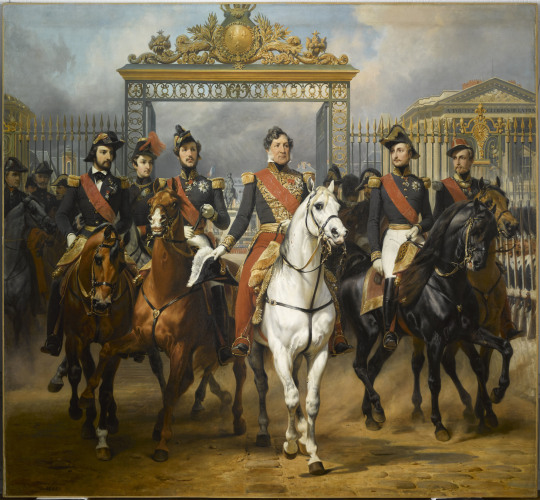
Louis Philippe and His Sons
Artist: Horace Vernet (French, 1789–1863)
Genre: History
Date: 1846
Medium: Oil on canvas
Collection: Palace of Versailles, Paris, France
Depicted People:
Louis Philippe I
Prince Ferdinand Philippe, Duke of Orléans
Prince Louis, Duke of Nemo
Prince Henri, Duke of Aumale
Prince Antoine, Duke of Montpensier
Description
Louis-Philippe and His Sons Riding Out from Versailles is an 1846 oil-on-canvas painting by the French artist Horace Vernet. It features a group portrait of Louis Philippe I and his sons riding out from the Palace of Versailles. Versailles, once the residence of the House of Bourbon during the Ancien régime before the French Revolution, had been abandoned for several decades. During the July Monarchy Louis Philippe oversaw its restoration as a national museum. Vernet's painting commemorates its inauguration on 10 June 1837. The king rides out through the gates accompanied by his five sons the Duke of Orléans, the Duke of Nemours, the Prince of Joinville, the Duke of Aumale and the Duke of Montpensier. Orléans, the king's eldest son and heir, had subsequently died in a carriage accident in 1842.
The painting was commissioned by the king to hang in Versailles, where it remains.
#painting#history#louis philippe i#prince ferdinand philippe#prince louis#prince henri#prince antoine#french empire#french monarchy#french monarch#equestian#french history#oil on canvas#palace of versailles#france#horses#gate#uniform#horace vernet#french painter#french art#french culture#artwork#oil painting#19th century painting#father and sons#house of bourbon
27 notes
·
View notes
Text

Saint Thomas More
1478-1535
Feast day: June 22 (New), July 9 (Trad)
Patronage: adopted children, civil servants, court clerks, difficult marriages, large families, politicians, lawyers, and statesmen
St. Thomas More was an English lawyer, social philosopher, author, statesman and noted Renaissance humanist. He was also a counselor to Henry VIII and Lord Chancellor from October 1529 to 16 May 1532. More opposed the Protestant Reformation, in particular, the theology of Martin Luther and William Tyndale. He also wrote Utopia, published in 1516, about the political system of an ideal and imaginary island nation. More opposed the King's separation from the Catholic Church, refusing to accept him as Supreme Head of the Church of England, and what he saw as Henry's bigamous marriage to Anne Boleyn. Tried for treason, More was convicted and beheaded.
Prints, plaques & holy cards available for purchase here: (website)
79 notes
·
View notes